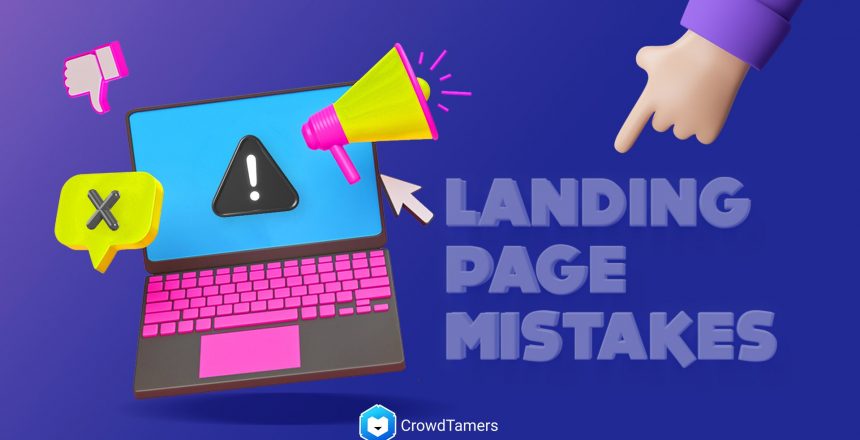Landing pages are serious business. So, in today’s blog, let’s talk about the mistakes killing your conversion rates and how you can avoid them.
Mistake 1 – Not having enough landing pages
Studies show that the more landing pages businesses have, the better results. Why? Because these businesses are creating landing pages to highly specific buyer needs rather than trying to appeal to everyone with the same few pages. Trying to achieve everything with your landing page sets you up for failure even before starting.
How to avoid this mistake
Create separate landing pages for different buyer personas, conversion goals, each stage of the consumer journey – not just your products/services. For example, if one of your conversion goals is to generate sign-ups to a free trial for your product, create specific landing pages to target marketing managers, IT pros, sales teams, or whatever your target audiences may be.
Mistake 2 – Not optimizing your forms for conversions
One of the biggest friction points on any landing page which ultimately affects your conversion rates, is the web forms. There is no easy way to approach this topic, but designing forms with conversions in mind from the beginning is the best place to start. From here, you can optimize your forms overtime to remove problematic fields, and other design issues preventing conversions.
How to avoid this mistake
To start with, get yourself a good form optimization tool that will help you track performance and easily edit your forms to make any further improvements. Best practices used to tell us that shorter forms outperform the long ones, but recent studies have shown that this isn’t always the case. Multi-step forms are a relatively new trend generating incredible conversion rates, especially those designed, so they don’t look like forms.
Mistake 3 – Neglecting buyer concerns
No matter how good your offer is or how good your landing page sells it – people will still have doubts about buying into your brand. It is difficult for people to trust a faceless brand, especially when they see your landing page/brand for the first time – and neglecting these buyer concerns is a big mistake.
How to avoid this mistake
The most obvious way to tackle this problem is using trust factors like customer reviews, testimonials, industry awards, & other forms of third-party feedback that give users their seal of approval. Another tactic is to provide guarantees over common concerns. For example –
- Privacy policy
- No credit card details required
- Money-back guarantee
Identify what concerns each of your target audiences will have with your conversion goals and try to reassure them.
Mistake 4 – Slow loading time
All your hard work of create landing pages that convert will count for nothing if people leave before your site finishes loading. As the web matures, user expectations on loading times become more demanding, leading to many brands falling behind. Pages that take longer than 2 to 3 secs to load lose more than 50% of their visitors, which accounts for most landing pages. his greatly affects your conversion rates which is why you need to ensure that you don’t fall into this category.
How to avoid this mistake
Keeping on top of loading times needs to be one of your priorities, and this involves several key factors:
- Keep your web code clean
- Use a fast hosting provider
- Minify your website files (HTML, JS, CSS, etc.)
- Regular speed tests
- Sign up to a content delivery network
- Use web caching
- Image optimization
- Minimize server requests
- Minimize page redirects, etc.
Loading times are one of those things you have to work at regularly, and it is not that only the users demand speedy landing pages. Page speed is a ranking factor in Google’s search algorithm, and it plays a role in Ad Rank, which determines whether your PPC ads show and where they appear on the page.
Mistake 5 – Beating around the bush
With a specific message and goal in mind, you now have to get this across in a compelling way – and you’ve got a matter of seconds to do this. In 2006, studies found that users make up their minds about a website “in the blink of an eye” – or 50 milliseconds to be precise.
This means, if your message does not get right to the point and convince visitors that you have something valuable to offer, you have got a problem.
How to avoid this mistake
Strip down your marketing message to the core value proposition you are offering. Tell people what problem you are solving. Let your message seak to how you’re improving their daily lives, or whatever benefit is key to your offer. For PPC landing pages, try to match the headline on your page with the headline of your ad. None of this should be difficult if you create enough landing pages, each with its own relevant message.
Landing pages are serious business.
All of the mistakes that we have discussed today can be avoided by taking three things seriously. Audience research, user experience, and relevance. Once you know what each of your target users wants, create highly specific marketing messages that strike a chord with them. Your copy will sound more convincing, the benefits of your offer will become clear, and your calls to action will be difficult to resist.
All that is left is to package this in a user experience that removes all conversion barriers. This way, your fleet of landing pages is set up to get serious business results.



